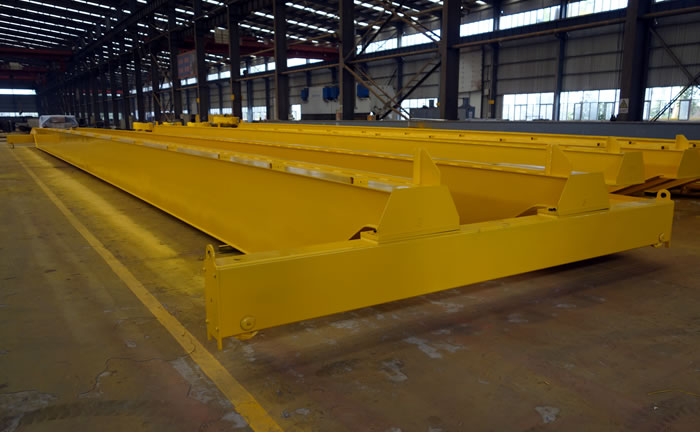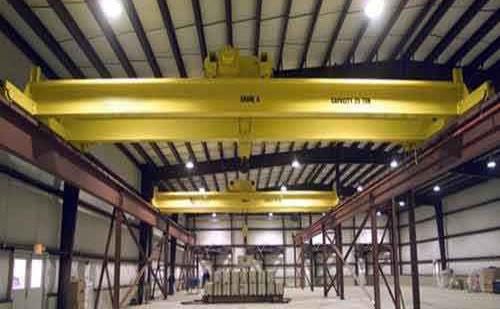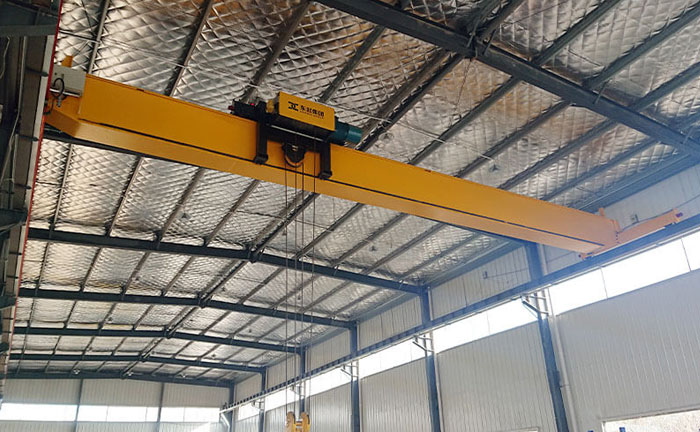Different types of 3 ton overhead crane for Sale with factory price:
3 ton Single Girder Overhead Crane for Sale:
- Lifting capacity: 3t
- Lifting span(m): 7.5~28.5m
- Power supply(V): 220-480/3/50
- Price(USD): $2,600 to $41,000
Get Latest Price
3 ton Double Girder Overhead Crane for Sale:
- Lifting capacity (T): 3t
- Lifting span: 10.5~35.5m
- Power supply(V): 220-480/3/50
- Price(USD): $5,000 - $66,000
Get Latest Price
3 ton Top-Running Overhead Crane for Sale:
- Lifting capacity: 3t
- Lifting span(m): 10.5~31.5m
- Power supply(V): 220-480/3/50
- Price(USD): $3,000 to $35,000
Get Latest Price
3 ton Underhung Overhead Crane for Sale:
- Lifting capacity (T): 3t
- Lifting span: 3~15m
- Power supply(V): 220-480/3/50
- Price(USD): $3,000 to $45,000
Get Latest Price
3 ton Free Standing Bridge Crane for Sale:
- Lifting capacity: 3t
- Lifting span(m): 1~9m
- Power supply(V): 220-480/3/50
- Price(USD): $2,000 to $45,000
Get Latest Price
3 ton Low Headroom Single Girder Overhead Crane for Sale:
- Lifting capacity (T): 3t
- Lifting span: 7.5~22.5m
- Power supply(V): 220-480/3/50
- Price(USD): $3,500 to $40,000
Get Latest Price
3 ton overhead crane for Sale design drawing:

Choosing the Right 3 Ton Overhead Crane:
Choosing the right 3 ton overhead crane involves several considerations to ensure it meets your operational needs safely and efficiently.
- Load Capacity: Ensure the overhead crane's capacity matches or exceeds the maximum load you’ll be lifting (consider dynamic loads and safety factors).
- Span and Height: Determine the span (distance between support structures) and lift height required for your operation. Measure the workspace to ensure the overhead crane fits.
- Power Source: Choose between electric, hydraulic, or manual cranes based on your power availability and lifting frequency.
- Control System: Decide on control options: pendant control, remote control, or cab control, based on your operational environment and safety requirements.
- Environment: Consider whether the 3 ton overhead crane will be used indoors or outdoors, and assess conditions like temperature, humidity, and exposure to chemicals or dust.
- Speed of Operation: Look at lifting and traveling speeds. Faster operations may require more precise control systems.
- Safety Features: Ensure the 3 ton overhead crane includes safety features like overload protection, emergency stop, and limit switches to prevent accidents.
- Maintenance Requirements: Evaluate ease of maintenance and serviceability, including access to components for repairs and inspections.
- Cost and Budget: Balance your budget with the quality and features of the 3 ton overhead crane. Sometimes investing more upfront can lead to lower long-term costs.
Safety First: Key Features to Look for in a 3 Ton Overhead Crane
- Overload Protection: Overload Sensors: Prevent lifting loads beyond the 3 ton overhead crane's capacity, triggering alarms or stopping operation.
- Emergency Stop Switch: Easily accessible emergency stop buttons that can halt 3 ton overhead crane operation immediately in case of an emergency.
- Limit Switches: Prevent over-travel of the hoist and overhead crane movements, stopping operation when reaching maximum height or horizontal limits.
- Safety Locks and Latches: Mechanisms that ensure the hoisting equipment remains securely in place during operation and prevents accidental disengagement.
- Anti-Collision Systems: Sensors or devices to prevent collisions between the 3 ton overhead crane and other objects or structures in the workspace.
- High-Quality Hoist: Choose overhead crane with reputable hoists that include features like brakes, gears, and pulleys designed for safety and reliability.
- Control Systems: Ergonomic control systems that are intuitive to use, reducing operator fatigue and error potential. Remote controls can enhance safety by keeping operators at a safe distance.
- Regular Maintenance Access: Design that allows easy access to critical components for regular maintenance checks, ensuring ongoing safety and reliability.
- Warning Lights and Alarms: Visual and audible signals to alert personnel of overhead crane operation or potential hazards, enhancing situational awareness.
- Operator Training and Certification: Ensure that operators are trained and certified in safe overhead crane operation practices, including load handling and emergency procedures.
- Robust Structural Design: A crane built with high-quality materials and engineering standards to withstand operational stresses and environmental conditions.
- Ground Stability and Installation: Ensure the crane is installed on a stable foundation to prevent tipping or swaying during operation.
Installation Tips for Your New 3 Ton Overhead Crane:
Installing a new 3 ton overhead crane requires careful planning and execution to ensure safety and optimal performance.
1. Site Assessment
Evaluate the Workspace: Ensure the area is suitable for 3 ton overhead crane installation, considering factors like overhead clearance, floor space, and ground stability.
Check for Obstructions: Identify any potential obstacles that could interfere with crane movement.
2. Plan the Layout
Determine the Crane Path: Map out the intended path for the 3 ton overhead crane, including travel distances and turning points.
Position Support Structures: Ensure that the runways or gantry supports are positioned correctly to support the 3 ton overhead crane's weight and operational needs.
3. Foundation Preparation
Install Appropriate Foundations: Ensure the foundation meets load-bearing requirements, using concrete pads or structural steel as needed.
Level the Surface: A level foundation is critical to prevent uneven wear and operational issues.
4. Assembly Instructions
Follow Manufacturer Guidelines: Use the installation manual provided by the manufacturer for specific assembly instructions and torque specifications.
Use Proper Tools: Ensure you have all necessary tools and equipment for assembly, including overhead crane, hoists, and lifting devices.
5. Electrical and Mechanical Connections
Hire Qualified Personnel: Use certified electricians for any electrical work to ensure safety and compliance with local codes.
Check Connections: Verify all electrical and mechanical connections before powering on the overhead crane.
6. Safety Features Installation
Install Safety Devices: Ensure all safety features (like limit switches and overload protection) are correctly installed and tested.
Set Up Warning Systems: Implement audible and visual alarms to enhance safety during operation.
7. Testing and Inspection
Conduct Initial Testing: Test the overhead crane at various load levels to ensure it operates smoothly and safely.
Perform Safety Checks: Inspect all components and systems to ensure they are functioning correctly before regular use.
Maintenance Best Practices for Long-Lasting 3 Ton Overhead Cranes:
1. Regular Inspections
Daily Checks: Inspect critical components like hooks, chains, and hoists for signs of wear or damage before each use.
Weekly Inspections: Check for any visible signs of rust, leaks, or misalignment, and ensure safety features are operational.
Monthly and Annual Inspections: Schedule more thorough inspections by a qualified technician to evaluate the entire system, including structural integrity.
2. Lubrication
Follow Manufacturer Guidelines: Use the recommended lubricants and follow the schedule provided in the owner’s manual.
Lubricate Moving Parts: Ensure that bearings, gears, and joints are regularly lubricated to reduce friction and wear.
3. Cleaning
Keep It Clean: Regularly clean the 3 ton overhead crane to remove dirt, debris, and contaminants that can affect performance and safety.
Inspect for Corrosion: Pay special attention to areas prone to rust, and treat them as necessary.
4. Load Monitoring
Adhere to Load Limits: Always operate within the 3 ton overhead crane’s specified load limits to prevent undue stress on the system.
Use Load Indicators: If available, utilize load indicators to monitor weight during operation.
5. Electrical System Checks
Inspect Wiring and Connections: Regularly check for frayed wires, loose connections, and signs of wear in the electrical system.
Test Safety Devices: Ensure that limit switches, emergency stops, and other safety features are functioning correctly.
6. Calibration
Regularly Calibrate Controls: Ensure that controls and indicators are accurately calibrated for precise operation.
Test Functionality: Perform regular tests of all controls to ensure they respond correctly.
7. Safety Protocols
Implement Safety Procedures: Ensure that all maintenance activities are conducted following established safety protocols to protect personnel.
Use Personal Protective Equipment (PPE): Ensure maintenance personnel wear appropriate PPE during inspections and repairs.
By following these maintenance best practices, you can extend the lifespan of your 3 ton overhead crane while ensuring safe and efficient operation. Regular attention to maintenance not only prevents costly repairs but also enhances workplace safety.
Cost vs. Value: Understanding the Investment in a 3 Ton Overhead Crane
1. Initial Costs
Purchase Price: The upfront cost of the 3 ton overhead crane, which can vary widely based on brand, features, and specifications.
Installation Costs: Expenses related to the installation process, including foundation preparation, assembly, and any necessary electrical work.
Transportation Fees: Costs for shipping the overhead crane to your facility.
2. Operating Costs
Energy Consumption: Consider the energy costs associated with operating the 3 ton overhead crane, especially if it uses electric power.
Maintenance Expenses: Regular maintenance is essential to keep the 3 ton overhead crane operational, which involves parts, labor, and service contracts.
Training Costs: Investing in operator training is crucial for safe and efficient use, which may incur additional expenses.
3. Value Considerations
Increased Productivity: A well-functioning overhead crane can significantly enhance workflow efficiency, allowing for quicker material handling and reducing downtime.
Safety Improvements: By reducing manual lifting and moving of heavy loads, cranes minimize the risk of workplace injuries, which can lower workers’ compensation costs and enhance overall safety.
Longevity and Reliability: A quality crane, when maintained properly, can have a long lifespan, providing value over many years of service.
Versatility: Overhead cranes can be used in various applications, making them valuable assets that can adapt to changing operational needs.
Customization Options for Your 3 Ton Overhead Crane:
Customizing your 3 ton overhead crane can greatly enhance its functionality and safety, ensuring it meets your unique operational demands. Collaborate closely with manufacturers to explore these options, aligning the 3 ton overhead crane's capabilities with your specific needs for optimal performance.
1. Hoist Configuration
Electric vs. Manual Hoists: Decide on the type of hoist that best fits your operation's frequency and load demands.
Dual or Single Reeved Hoists: Customize the hoist configuration to increase lifting speed or capacity.
2. Control Systems
Remote Control Options: Consider adding wireless remote control systems for enhanced operator safety and flexibility.
Cab Control: If operating in a larger facility, a cab with ergonomic controls may improve operator comfort and visibility.
3. Safety Features
Advanced Safety Systems: Incorporate additional safety devices like anti-collision sensors, emergency stop buttons, and overload protection systems tailored to your needs.
Cameras and Monitors: Adding cameras can improve visibility in blind spots, enhancing safety during operation.
4. Materials and Finish
Corrosion-Resistant Coatings: If your environment has harsh conditions, consider special coatings for added durability.
Custom Colors and Branding: Personalize the 3 ton overhead crane with specific colors or logos to enhance brand visibility.
5. Add-On Accessories
Trolleys and Carts: Customize your overhead crane with compatible trolleys for efficient load handling.
Lift Attachments: Consider adding specialized attachments for specific load types, such as hooks, slings, or spreader beams.
Applications of 3 Ton Overhead Cranes in Various Industries:
1. Manufacturing
Assembly Lines: 3 ton overhead crane facilitate the movement of heavy components between workstations, improving workflow efficiency.
Material Handling: They are used to transport raw materials to and from storage areas and production lines.
2. Construction
Structural Steel Installation: Overhead cranes can lift and position heavy steel beams and other structural elements during building construction.
Precast Concrete Placement: They are essential for moving and placing large concrete panels or blocks.
3. Warehouse and Distribution
Load Management: Overhead cranes help in loading and unloading goods, particularly bulky or heavy items, streamlining warehouse operations.
Storage Solutions: They enable efficient stacking and retrieval of materials in high-density storage systems.
4. Automotive Industry
Parts Handling: Used for moving heavy engine components or large automotive parts during assembly or repairs.
Maintenance Facilities: Overhead cranes facilitate the lifting of vehicles or heavy machinery for inspection and maintenance.
5. Aerospace
Component Assembly: 3 ton overhead crane are critical in assembling large aircraft components, allowing for precise positioning of heavy parts.
Maintenance Hangars: They assist in lifting aircraft for maintenance checks and repairs.
6. Shipbuilding
Heavy Load Movement: Used to lift and move large sections of ships, such as hulls or decks, during construction.
Component Installation: Assist in positioning large engines and other heavy machinery within ships.
7. Energy Sector
Power Plants: 3 ton overhead crane handle heavy equipment and components for installation and maintenance, including turbines and generators.
Wind Farms: Used for assembling and maintaining large wind turbine components.
8. Metals and Steel Industry
Material Handling: 3 ton overhead crane are utilized for transporting raw metals and finished products throughout the facility.
Heat Treatment Processes: They can safely handle heavy loads in high-temperature environments, like furnaces.
9. Pharmaceuticals
Bulk Material Handling: Used for moving heavy containers of raw materials or finished products within manufacturing facilities.
Laboratory Equipment Installation: Assist in positioning heavy lab equipment and machinery.
10. Recycling and Waste Management
Material Sorting: 3 ton overhead crane are used to move and sort heavy recyclable materials, enhancing efficiency in recycling facilities.
Container Handling: They help in managing large containers of waste or recyclable materials during processing.
The adaptability of 3 ton overhead cranes makes them invaluable across various industries, significantly enhancing productivity and safety when handling heavy loads. Their ability to operate in tight spaces while providing precise control over heavy materials ensures their continued relevance in modern industrial applications.










